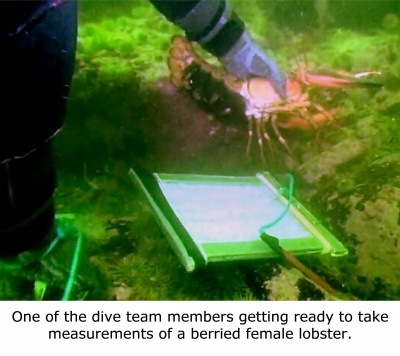
Groundbreaking Lobster Survey - Nov. 21, 2012
Originally published in ACFFA Annual Report 2012
The number of berried female lobsters more than tripled in an area near Grand Manan after a salmon farm began, according to a comprehensive lobster survey.

The first project of its kind, this lobster survey shows the number of berried females increased from eight in 2009 to 26 in 2010.
"Thats a huge increase," says Amanda Smith, a Marine Environmental Biologist with Sweeney International Marine Corp., the St. Stephen-based company conducting the survey. During the three years before Benson Aquaculture began a small salmon farm in Cheney Head, the total number of lobsters in and around the proposed farm ranged from 71-130, with berried females ranging from only three to eight.
During the three years of production when fish were contained in the net pens and sea lice management actions were taken, the number of lobsters skyrocketed to as high as 251 in August 2011. The number of berried females hit 24 that year too. Lobster numbers remained high the following year when the farm was fallow, with between 134-169 lobsters in August and September 2012.
"What the survey is clearly showing at this point is that the salmon farm did not have a negative impact on the lobster populations," says Bob Sweeney, owner of SIMCorp.
Sweeney says this lobster survey is unique and groundbreaking because it includes three years of solid baseline data collected before the farm operations began. To his knowledge, a comprehensive survey of this kind hasnt been done anywhere else in the world, he says. The project involved sending divers down to swim along several transects each of which were 1000 feet in length along the ocean floor so they could identify the lobsters, measure them, compile numbers of males, females and berried females as well as count scallops. All the surveys were videotaped; the divers, scientists and designated survey locations were approved by the Department of Fisheries and Oceans.
"The data collected is extremely beneficial to fishermen because it helps answer some of their questions and its beneficial to our industry and researchers," says Sweeney. "It helps answer questions about what impact does a farm have on lobster population, and this survey shows the farm did not have a negative impact."